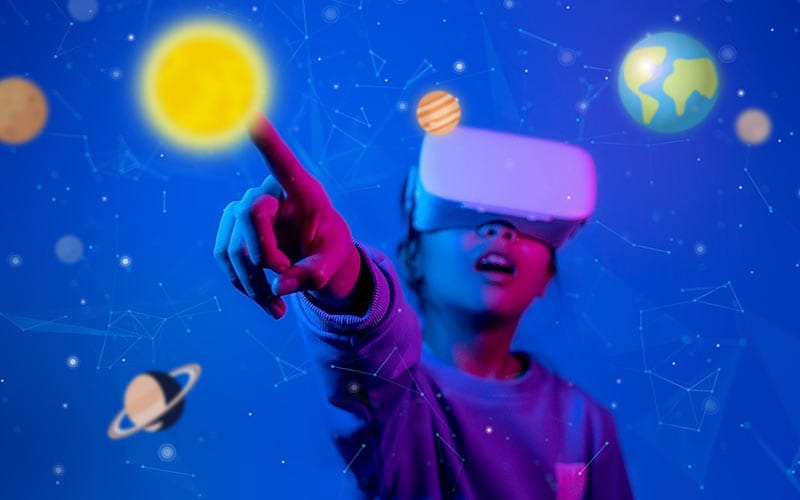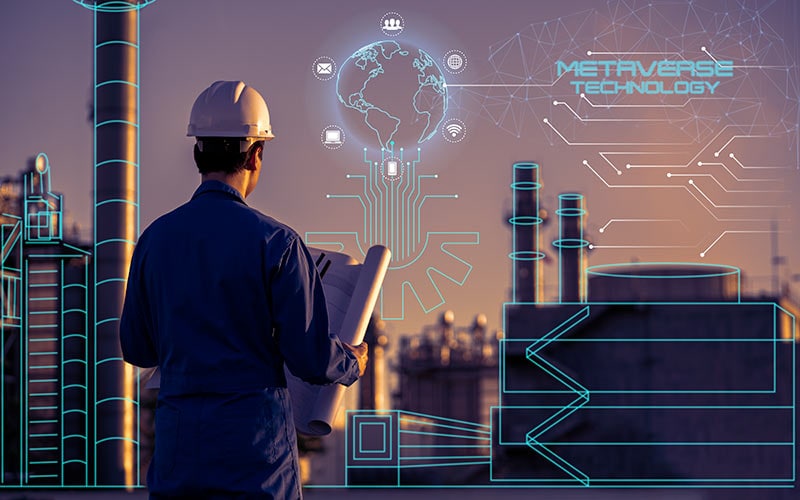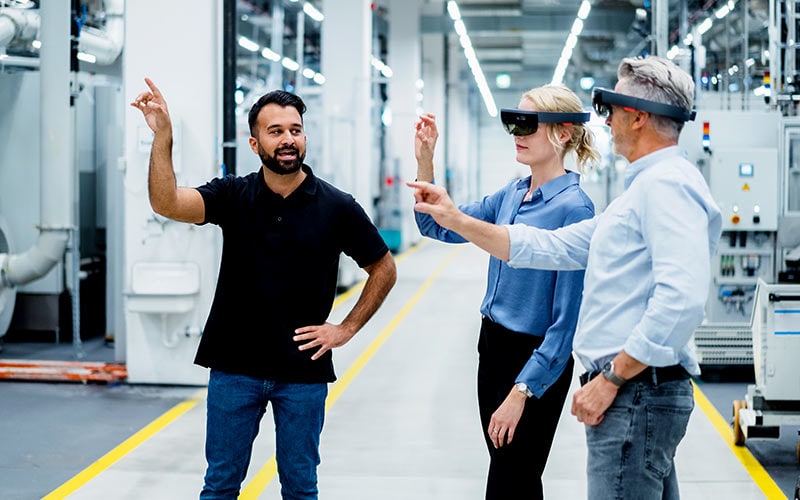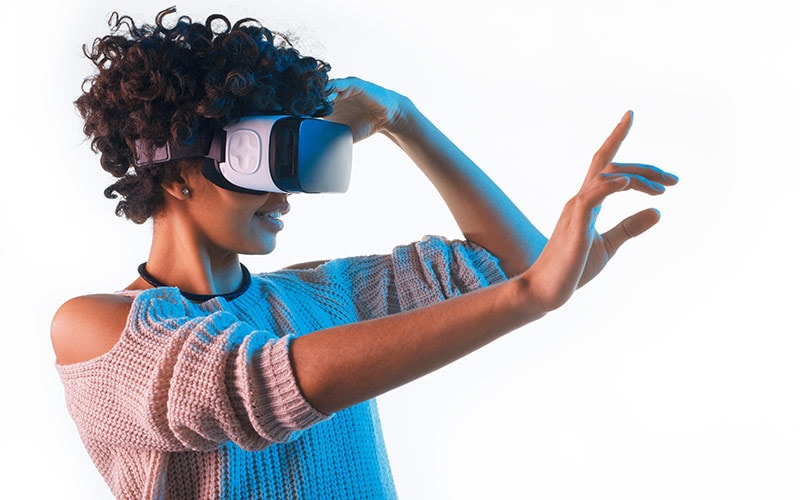Insights
- The metaverse will be a bringing together of existing and emerging technologies
- Many of these technologies are already in use, from industry and business to retail, commerce and entertainment
- These technologies offer great opportunities, but already bring challenges
- The metaverse will be more than just immersive entertainment experiences
- There are concerns around the huge quantities of personal data that metaverse experiences will gather from individuals
- The metaverse will depend on being able to process a great deal of information very quickly, which will be facilitated by edge processing
- Web3 technologies – blockchain, cryptocurrencies and NFTs – are facing headwinds
- Immersive and inclusive online spaces could be a boon to education
- The pandemic forced the use of collaborative tools for remote working and metaverse evangelists predict that these tools will grow in popularity as they move into the metaverse
- Sustainability is a challenge with metaverse technologies: while moving to virtual spaces could cut down travel, there is concern about the energy consumption of blockchain and cryptocurrencies
- The metaverse is not yet the continuous, persistent, overarching world that enthusiasts expect to happen
Introduction
“Metaverse” is a buzzword that’s hard to avoid now: brands, vendors, and the biggest tech platforms seem to be constantly talking about it.
But what exactly is the metaverse? Is it an immersive 3D game on steroids? Is it the new way to work in the coming years? Is it all of these, or none?
We can think of the metaverse as a world where humans are connected to digital twins of themselves (and everything else imaginable), with identities and assets completely run by code and transferable across platforms.
In its simplest form, says Vishwa Ranjan, virtual and augmented reality leader at Infosys, the metaverse “can be thought of as the next iteration of the web”, where “lines are getting blurred between physical and digital worlds”.
In fact, what we think of as the metaverse is a confluence of technologies, from extended reality (XR), Internet of Things (IoT), and 5G connectivity to graphics, displays, and the cloud. These will be used to build a persistent online space, where industries, offices, entertainment venues, theme parks, brand experiences, and more will all be connected, allowing users and their digital twins to seamlessly wander between these experiences — buying goods, going to work, going to concerts, and more.
Source: Infosys Knowledge Institute
In this guide we discuss each technology we think will shape the metaverse — from XR to edge computing, and from blockchain to IoT. We explain what each technology is, how it’s used now, how we think it will be used in the metaverse, and what the challenges around the technologies are.
Of the many use cases of the metaverse, we look in detail at education, retail, the world of work, and industry, considering what’s there and what’s next.
We hope you find this useful.
XR
What is it?
XR is the catch-all abbreviation for “extended reality”, covering virtual reality (VR) and augmented reality (AR).
VR creates an immersive, 3D experience: many sporting and theatre events have recently offered VR experiences, where the user wears a headset to experience an event without physically being there. If you’ve seen the film Ready Player One, the Oasis world of that movie is an immersive virtual reality space.
As the name suggests, AR augments reality by adding digital elements, overlaying information such as details about a building or a venue in Google Maps, via a mobile phone, a headset or smart glasses and contact lenses.
Where is it used?
Most people are at least slightly familiar with the use of VR, which is enabled by a headset worn by the user to create an immersive experience of a game, or a theatre, museum – or another cultural space.

Now, VR is increasingly used in business and education areas, from automotive design to architecture and retail, and from HR to education. Organizations are using VR to prototype car designs, show clients architectural plans, onboard employees remotely, and make education lively and immersive for geographically scattered students.
AR also already has a foothold in consumer and industry applications. Social media platform Snapchat lets users to add filters like cat faces or bunny ears to other people’s faces in real time. Snap recently debuted “Custom Landmarkers” that let creators overlay information onto locations and venues. Another example is Google Maps’ Live View feature, which overlays directions on a live video of where you are to help you navigate.
Meanwhile, in healthcare, AR is being used to overlay radiological images on to live images to help train surgeons, while vehicle firms use AR to train mechanics and plan maintenance.
What is its role in the metaverse?
VR and AR will remain vital in the metaverse journey. The next generation of devices will make current applications more accessible and common. At present, VR headsets are cumbersome, expensive and only work in their own siloed virtual spaces. Similarly, current AR applications do not yet work outside of their own functions. The vision of the metaverse is that these will work seamlessly across joined-up, persistent virtual, and augmentable spaces.
Challenges to adoption
While most modern smartphones can run AR applications, the current generation of VR headsets is cumbersome, uncomfortable, and expensive. AR glasses that overlay information onto lenses are not fully realized. Similarly, smart contact lenses are barely out of the starting gate. Also, many users report nausea when using VR goggles.
That said, the success of these devices largely depends on developments in user experience.
The pandemic taught us that the nuance of personal interaction suffers when it’s mediated by a screen: that will also hold true in the metaverse. Humans can read tiny, subtle interactions with some precision in the flesh, but it will be much harder to do so when your interlocutor is a smoothed-out 3D avatar.
Personal interaction suffers when it’s mediated by a screen. That will also hold true in the metaverse
Adding another class of device to corporate IT estates creates further security risks, so XR devices such as goggles or glasses will have to be able to be hardened for use with organizations’ networks.
Digital twin
What is it?
A digital twin is a virtual representation of a physical object, a person, or a process. Most people are familiar with an avatar in a computer game, where users choose digital characters (known as avatars) to represent themselves in the game world. This is a digital twin (even if your avatar looks like an elf with enchanted armor).
More prosaically, digital twins are used to model real-world processes, from the performance of a single component in a bigger machine to how different items and processes interact in a bigger system, such as a supply chain.
Digital twins rely on sensors feeding data from real-world items, whether that’s a machine component in a factory, a container ship sailing around the world, or humans taking part in medical trials. Engineers and AI use data from these sensors to predict and model behaviors and responses.
Where is it used?
The automotive industry already uses digital twins. The South Korean carmaker Hyundai recently announced a pilot project to better model battery lifespan in electric vehicles using digital twins of those cars. The company uses a Microsoft Azure digital twin platform by pulling in data on charging, driving habits, and the driving environment from its IONIQ 5 cars to model battery performance for its future cars.
BMW has also invested in digital twin technology, building a virtual representation of its factory in Regensburg, Germany, using NVIDIA’s Omniverse Enterprise platform. This allows BMW to simulate changes to its manufacturing process and optimize and document changes before rolling them out to the real factory floor.1
Digital twins are also used in healthcare: efficacy and potential side-effects of new drugs in development can be modelled in digital twins of products created for clinical trials, for example.
What is its role in the metaverse?
Metaverse applications will build on existing digital-twin technology and use data from real-world sensors to create immersive experiences for users. Retail is one key area, where shoppers can send their digital twins, complete with accurate size measurements, into virtual stores to look at and try on 3D representations – twins – of actual stock available to the customer.
In businesses, digital twins of individuals will connect with digital versions of customers, users, suppliers, and contractors in the metaverse to model factory outputs, to work out efficient use of buildings, and to view homes to buy. Relying on real-world data supplied by IoT sensors, many of the things we now fly or drive to can be modeled by a digital twin in a 3D immersive space. The possibilities are as broad as our imaginations.
Challenges to adoption
Digital twins rely on a great deal of data arriving quickly and securely from the real world model in a usable format – all of which is easier said than done.
There are particular concerns around personal data: there is a growing backlash around the capture and use of data about individuals, especially sensitive data related to health and finance. Organizations that want to build healthcare applications will need to demonstrate they are responsible, secure, and respectful with people’s most personal data, which is already a challenge.
The concern raised about the period-tracking app Flo2just one example of rising concern about companies’ stewardship of intimate data. Consumers should be comfortable about the constant flow of data their digital twins will stream and share with third parties.
Data standards and compatibility are also vital for creating and adopting digital twins. The metaverse will be an always-on umbrella that connects myriad digital spaces together. Data needs to flow across boundaries between organizations, countries, and platforms, and in formats that most providers can access and process.
Low-code, no-code
What is it?
As the name suggests, low-code no-code (LCNC) is a way of building applications without digging into the nitty-gritty of coding. There’s no need to know Python, Ruby, Java, or any other scripting and software development language as a user. Instead, users are presented with a graphical interface that can involve point-and-click creation of a flowchart by dragging and dropping building blocks or working through “if this then that” statements to create an application. Once the steps are complete, the code is generated under the hood.
With LCNC, businesses don’t need to engage pro developers all the time. Users with little to no coding experience (termed citizen developers) can build bespoke, boutique applications and speed up deployment within organizations.
And it’s a growing market: Gartner expected the low-code market to reach $13.8bn in 2021, up 22.6% from 2020, partly driven by the surge in remote development during the pandemic.3
Where is it used?
You may be familiar with a widely used low-code no-code tool: WordPress. The web publishing platform offers users with no HTML skills a way to write and publish posts online. The posts are written in a template that can be implemented off the shelf or in one that’s been built bespoke for the publisher. Users can easily view underlying HTML code used by such blogging and content-management systems. However, most users are happy with these features and don’t want to dig deep inside the underlying code.
LCNC helps small businesses build processes quickly and inexpensively for their workflows, virtual assistants, and analytics tools. LCNC tools and processes enable citizen developers to build and automate processes that fit their needs.
What is its role in the metaverse?
LCNC is already used in immersive gaming, allowing users to create and customize avatars and their clothes, weapons etc, and this will translate into the metaverse. Participants will use tools that let them build and tweak their virtual look.
There are many benefits of LCNC tools, both now and in the metaverse future. For instance, retailers will be able to build their virtual presence and manage inventory using software that lets them create and deploy their 3D online stores without spending huge amounts on developers. Other business processes should be able to be built and rolled out quickly too, from HR processes to prototyping.
Low-code platform Mendix found in a 2021 survey that low-code projects can reduce the costs of development by 53%, while customer apps built using low-code platforms boosted revenues by an average of 58%.4
Allowing employees to use LCNC platforms to build tools that suit them can reduce shadow IT issues, where employees create workarounds using unauthorized third-party tools.
Challenges to adoption
One key issue for anyone deploying LCNC — either in the metaverse or in the current business environment — is security. While users don’t have to write code using these tools, there is code under the hood. The lack of visibility into exactly how an LCNC app functions poses security risks.
A further challenge is that “citizen developers” — whether employees or metaverse users — will cobble applications together, without knowing how they fit into the bigger entity. This will keep brand managers, compliance managers, and data protection officers on their toes.
And data is potentially an issue, especially in the metaverse, where organizations rely on huge quantities of data to create deeply personalized experiences. Tools and apps put together by individuals using third-party platforms make it difficult to track what data is collected, how it’s processed, and where it’s stored.
LCNC has the potential to help users, both in and outside the metaverse, create applications and experiences that enrich bigger entities. Still, there is a potentially bumpy road ahead without careful oversight of what’s being built.
Edge computing
What is it?
Put simply, edge computing means processing that’s done at or near the source of the data, not in the cloud. The aim is to harness the processing power of multiple devices and speed up functions.
The buzzword here is “latency” — the time it takes for information to be processed and to return the response. For example, if you use a smart assistant such as Alexa to control your lights, you’re probably aware of the delay between you telling Alexa to turn off the bedroom lights and the lamps actually switching off. The delay is because your voice command is sent to the cloud, then parsed, connected to your smart light switch, and then sent back to your house to turn off the lights.
Edge computing aims to do the processing at or very near the data source, implying commands and processes will happen promptly. Modern devices, from sensors to cameras, and mobile phones to smart lights, can fulfill many processing requirements on the device itself.
Where is it used?
Perhaps the most familiar use of edge computing can be seen on mobile phones: even inexpensive devices do a lot of intensive processing on the cellphone itself. The most visible example is the processing done to photos taken on the phone, from fixing the exposure to removing unwanted objects via computational photography, but some cell phones can also perform tasks such as identifying music without sending the data to the cloud.
Authentication is carried out on cell phones and laptops rather than being sent to the cloud for verification.
Towns and cities use edge computing to build and optimize smart power grids: sensors and consumer devices gather and feed data into AI-driven load management and forecasting. Processing that volume of data in the cloud increases latency — and cost — so processing data locally can improve efficiency.
Edge computing is being used on the oceans, and even in space. The Mayflower autonomous ship5, a marine research vessel, gathers data about the ocean and makes its own AI-powered decisions about its route, status and mission, thanks to 15 edge devices that allow the ship to operate independently. It syncs with the cloud and uploads data and downloads updates when it gets a connection.

Sensors on satellites are drawing on edge computing to process data from weather observation and other functions and are expected to do more and more processing in space rather than sending it back to the earth.6
The technology is also used in manufacturing, construction, and transport to gather and process data from multiple inputs for analytics and planning more quickly, cheaply, and efficiently.
What is its role in the metaverse?
The metaverse will require enormous data at speed in real time — from the data needed to render virtual representations of individuals (or avatars), to using 3D imaging for medical diagnosis — and from AI-driven data processing to running design and education simulations using digital twins.
Sensors and devices will generate a constant firehose of data. For instance, they will read your facial expressions and send those parameters to your team members, so that their avatars can respond appropriately to yours. These devices will manage information from manufacturing processes to achieve maximum efficiency. All of that will depend on processing that data as quickly and as seamlessly as possible — which means as close to you as possible.
Challenges to adoption
Edge computing relies on fast, robust networks, including but not limited to 5G cellular networks. However, 5G rollout is by no means complete around the world: the GSMA, an industry body representing mobile network operators, estimates that it won’t be until 2025 that 5G networks will cover even a third of the global population.
Controversies and concerns around 5G globally have slowed the rollout of technology. The onset of COVID-19 and concerns about the presence of Chinese technology also contributed to delays in implementing 5G networks and services.
Blockchain
What is it?
At its most basic, a blockchain is a decentralized ledger. Each participant, or peer, holds a copy of the ledger, and each copy of the ledger is linked in a peer-to-peer network. This structure means every entry on the blockchain is checked and verified by each peer, which in turn means that it’s considered nearly impossible to alter or delete data once it’s entered into the ledger.
Blockchains are mostly used to record financial transactions. However, they can be used to record any kind of data, from ownership of a digital asset such as a non-fungible token (NFT), to supply-chain compliance.
Because of its peer-to-peer, decentralized nature, there is no single, centralized authority over what’s entered on a blockchain. This sets blockchains used for transactions apart from traditional institutions such as stock exchanges and banks, which control their infrastructure.
While there is much talk of “the blockchain”, there are in fact many blockchains. The popular ones — the Bitcoin and Ethereum blockchains — are public, and this transparency is a key factor in their favor. Anyone can view their transactions, although one can’t know who has been a party to a transaction.
The Ethereum blockchain has additional functions to verifying cryptocurrency exchanges, including executing and verifying code called “smart contracts” that let people transact with one another without a central authority.
Organizations also maintain private blockchains to record commercially sensitive data. These private blockchains only allow verified participants to add data to and view their blockchains.
Where is it used?
Blockchains have been since 2009. Their original use was to record and verify cryptocurrency mining — or coin creation — and transactions. Blockchains still underpin the creation, spending, and exchange of cryptocurrencies. Now, fintechs such as Chainalysis use blockchain tech to connect fiat currency (government-backed money) to cryptocurrencies, and facilitate their exchange.
Blockchains are also useful in managing healthcare data, and tracking supply chains and ESG compliance among third-party suppliers.
What is its role in the metaverse?
Blockchain use in the metaverse will build on existing applications. Key functions will be financial transactions, smart contracts, tracking asset ownerships, and managing identity.
Challenges to adoption
Blockchains are controversial for several reasons. The most common concern is their environmental impact. Bitcoin and Ethereum are sharply criticized for their energy consumption. However, there are efforts in the crypto and blockchain spaces to move to a more sustainable approach.
Bitcoin energy consumption consumes some 191TWh a year, according to Digiconomist7, or roughly the power consumption of Thailand, while a single Bitcoin transaction is equivalent to nearly 2.8 million Visa transactions, or 205,229 hours of watching YouTube.
Bitcoin energy consumption consumes some 191TWh a year, or roughly the power consumption of Thailand
The Ethereum blockchain, according to Digiconomist, has an annual energy consumption of just under 70TWh per year, or roughly the same as the entire Czech Republic, while a single transaction on the Ethereum blockchain has an equivalent carbon footprint to 220,770 Visa transactions.8
Others believe that blockchains are unnecessary because existing technology — databases, global payment infrastructure, supply chain management and logistics, among others — is mature, established, and scalable.
Blockchains can also be slow to complete a transaction, with a Bitcoin transaction taking between 10 minutes and 90 minutes. Fees are payable for blockchain transactions — a Bitcoin transaction costs a few dollars now, although that price spiked to nearly $70 in April 2021. Transactions on the Ethereum blockchain are called “gas fees”, and are similarly volatile, with fees ranging from a few dollars to hundreds of dollars.
Cryptocurrency
What is it?
Cryptocurrency, or just “crypto”, has been a buzzword ever since Bitcoin was created in 2009. Since then, thousands of cryptocurrencies emerged, ranging from the original Bitcoin to other “coins”, as they’re also known. Statista estimates that there were more than 10,000 cryptocurrencies as of February 2022.9
These range from Tether, a “stablecoin” that claims to be pegged 1:1 to the US dollar and is used by traders to buy other cryptocurrencies, to Dogecoin, which was initially created as a joke in 2013. It uses the Shiba Inu dog from the “doge” meme10as its identifier. In May 2022 it had a market capitalization of just over $11bn.
Cryptocurrencies are digital money where the transactions are recorded and verified on a distributed ledger rather than by a central authority such as a country’s central bank. These distributed ledgers are called “blockchains”.
Where is it used?
Cryptocurrencies are largely used for speculative trading; Bitcoins are used for purchases in some places.
However, slow transactions, a volatile exchange rate, and unpredictable fees make cryptocurrencies unsuitable for day-to-day spending and finances.

These drawbacks were made sharply clear by the results of the Venezuelan government’s decision to drop its national currency, the inflation-plagued bolivar, as its currency, in favor of Bitcoin in 2021.
Some organizations are experimenting with digital currencies, with Facebook – now known as Meta – one of the most prominent. However, Meta’s project ran into hostility from regulators concerned that the digital giant was creating a shadow banking infrastructure, and the project has since been shelved.11
Some startups use bespoke cryptocurrencies, also known as coins or tokens, to raise funds. This is a way of bypassing the traditional, regulated means of raising funds to grow a business such as venture capital, stock market flotations, or bank loans. Buying these coins gives the investor a stake in the business and can also include early access to a product. However, as these financing vehicles are unregulated, they are extremely risky investments.
What is its role in the metaverse?
It is expected that cryptocurrencies will be the principal way to pay for goods and services in the metaverse. However, users will have to navigate discrete coins and currencies issued by vendors and service providers: anyone who has used an in-game currency will already be familiar with this concept.
Challenges to adoption
As we have seen, cryptocurrencies at present are not easy to use as a means of payment. Cryptocurrencies are volatile – their price fluctuates extensively – which means that they are a poor method of paying for goods. They’re also unregulated, which means there’s no protection for consumers if they are the victims of a scam. Meanwhile, trading in cryptocurrencies is complex — in addition to the knowledge required, there’s also a technology hurdle to clear with the use of exchanges, wallets, and security.
Regulators also dislike attempts to set up decentralized digital money schemes, as Facebook — now Meta — discovered when it unveiled plans in 2019 for its own global currency, Libra. By the beginning of 2022, the project had been halted12casting doubt not only on Meta’s ambitions, but on the ambitions of other platforms to offer decentralized digital currencies.
Nonfungible tokens (NFTs)
What is it?
A non-fungible token, or NFT, is a type of digital asset whose creation and ownership is registered on a blockchain. However, unlike a Bitcoin or indeed a real coin — where it doesn’t matter which one you hold so long as you have a Bitcoin or a pound coin – non-fungible tokens are unique. They are often represented as artworks: the Mona Lisa is nonfungible as there is only one Mona Lisa and it derives its value from that.
NFTs are recorded on a blockchain, and it is that unique record that creates its value: like the Mona Lisa, there is only one record, and ownership of that record is what’s traded.
NFTs are bought and sold on specialized marketplaces, and have attracted a great deal of attention over the past year thanks to a combination of the widely reported marketing - and subsequent price crash - of the Bored Ape Yacht Club collection of NFTs, and the adoption of NFTs as a way of engaging with and monetizing fans by sports clubs.
Where is it used?
NFTs have caught the imagination of the arts and sports worlds. Sports teams in particular have been building NFT products as “digital collectibles” to monetize fan engagement, while artists have been “minting” NFTs of their existing and new, wholly digital works. Most NFTs are part of the Ethereum blockchain.
Brands are also dabbling in NFTs and using them to create digital merchandise for customers, provide prizes for competitions and build relationships with fans. For example, the AMC cinema chain and Sony Pictures offered 86,000 NFTs to fans buying advance tickets to the film Spider-Man: No Way Home, with more than 100 NFT designs available through a partnership with Cub Studios, which in turn drove the second biggest one-day ticket sales AMC had ever seen.
Meanwhile, luxury brand Coach launched a collection of NFTs featuring the animals from its Snow City digital game, giving away 10 NFTs of each animal. Coach paired each prize NFT with a real-world custom-made handbag.
What is its role in the metaverse?
NFTs are expected to be a key way of creating and trading in digital assets in the metaverse, from artwork to hang in your virtual corporate HQ to buying new gear for your avatar. NFTs are also expected to be used to create, buy and sell virtual property in the metaverse.
Challenges to adoption
Market volatility is one of the main challenges for trading in NFTs: sales of NFTs crashed during the late spring of 2022 as concerns about the cost of living and the riskiness of NFTs started to bite.13
There is concern around the use of NFTs to monetize fan engagement by sports teams, given the unregulated nature of the cryptocurrencies used to buy and sell them: the worry is that they push people without a deep understanding of the space into products that are not appropriate for them, and regulators are stepping up their scrutiny of teams’ crypto deals.14
Some artists are finding that their original work is being “minted” and sold as NFTs without their consent,15raising concerns about intellectual property and copyright theft and how that might play out in the metaverse. And at the time of writing, sales volumes and prices of NFTs were collapsing. It’s by no means clear whether today’s concerns will be addressed by the time the metaverse is a mainstream product.
Education in the metaverse
What’s the vision?
While we tend to think of retail and gaming as the main use cases for the metaverse, education – from the very youngest children through to undergraduates, post-graduates and beyond – is set to be one of the most useful and compelling uses of the metaverse.
Instead of the static grid of faces listening to lessons or lectures we got used to during the pandemic, teachers will transport school children to immersive recreations of historic spaces such as vanished Tudor palaces, museums, and cultural institutions.
The metaverse will also be able to deliver learning across geographical boundaries. It won’t matter where a student is: they will be able to access learning wherever they are. For example, the Korea Advanced Institute of Science and Technology at Kenya’s Konza Technopolis outside Nairobi, which is due to open in September 2023, expects that the technology there will reduce the need for students to make the 60km commute from the Kenyan capital.16
In Europe, Glasgow University has partnered with EON to build an extended reality (XR) facility, where students from engineering to medicine will interact with systems, machinery, and the human body in an immersive 3D space.17
The metaverse will likely become an important way to deliver business education, helping MBA students model scenarios and understand business strategies in virtual representations of companies and larger enterprises. And additionally, it is hoped that guest lecturers will use interactive 3D spaces to deliver talks and seminars without having to travel to business schools, thus also improving sustainability.
The immersive spaces of the metaverse will provide students a safe, controlled, and deeply engaging way to experiment with and learn from scenarios from disaster recovery to surgical techniques and plan disaster responses. They willbe able to see outcomes and be prepared when they need to face these situations in the real world.
What are the challenges?
One of the main concerns about education, particularly for children, in the metaverse, is the need for safeguarding. While individual platforms have terms and conditions banning users under a certain age, the very nature of the metaverse means there won’t be a single set of rules to keep young people safe.
The metaverse will be a potentially infinite number of discrete immersive spaces that are joined together, with no single gatekeeper or central authority.
There have been any number of worrying stories about online spaces for children where predators have been found, from Habbo Hotel to social media platforms including TikTok and Facebook.
Concerns about inappropriate relationships between educators and young adults, abuse of power, free speech, and bullying won’t disappear in the metaverse, and navigating these issues in the metaverse is going to pose a difficult challenge.
We have also learned in the age of Web 2.0 that content moderation and safeguarding at scale is an enormous challenge. Educators and anyone who works with young or vulnerable people are going to have to navigate this space with care.
Retail in the metaverse
What’s the vision?
Shopping is one of the most eagerly anticipated use cases for the metaverse. The vision is of immersive virtual stores, where customers can try on a limitless range of merchandise and brands glean deep insights into their customers from the firehose of data they collect about their customers.
Another scope is “digital-twin” retail, where a real-world item is shipped to your home after you’ve virtually tried it or perhaps asked for customization. It is also expected that people will be able to buy virtual goods that exist only online.
These virtual goods, which could range from digital artworks and virtual houses to new kit and clothing for your metaverse avatar, are likely to rely on NFTs, or non-fungible tokens. An NFT is a unique digital creation that is recorded on a blockchain, which means its ownership and uniqueness can be verified.
Property and real estate sales are also expected to be a use case for the metaverse. Here, estate agents will show digital twins of homes to potential buyers, while architects willbe able to design homes that involve their clients every step of the way thanks to being able to show them the progress via 3D technology.
Brands are already dipping their toes in virtual 3D spaces. Nike has a virtual store in the immersive game Roblox, where customers can exchange “Robux”, the in-world currency, for virtual shoes, clothes, and accessories.
Luxury brand Balenciaga opened a virtual store in the immersive game Fortnite in September 2021,18where players could buy branded weapons and skins for their in-game avatars. The brand also offered a limited-edition collection of hats, t-shirts, and hoodies for sale in the real world.
Other brands also offer goods in existing 3D spaces, among them Ralph Lauren with their Polo shops in Roblox, the fashion group Zara offering virtual items of clothing in Zepeto, the South Korean virtual space, and H&M showcasing its “all vegan” collection in the game Animal Crossing.
What are the challenges?
One key challenge, which applies to all use-cases of the metaverse, is that many discrete spaces described as “the metaverse” are not yet connected, and there is no way to move seamlessly between virtual worlds. Nor is there a common currency that can be used in multiple different spaces: most of them have their own digital currencies, from Roblox’s Robux to Fortnite’s V-Bucks.
Advocates of cryptocurrencies point to the decentralized nature of their blockchain-based coins as the solution, but cryptocurrencies are an unsatisfactory way to buy things. Their value is often extremely volatile, making it difficult to manage pricing; making and verifying transactions on the blockchain can be slow — and expensive — and they are largely unregulated, which makes them risky for consumers to use.
Another challenge is the increasing awareness of consumers about how third parties collect and use data. Brands will rely on access to an enormous amount of data to build targeted and personalized retail experiences and maximize sales, but their potential customers are increasingly concerned about how misuse of their data can negatively impact their privacy.
Access to technology could also limit the potential market: these metaverse spaces rely on consumers having the headsets and fast, reliable, and low-latency broadband networks to participate. Successful retail in the metaverse will in large part depend on customers having the right devices and access to broadband.
Metaverse in the world of work
What’s the vision?
Most people who have worked remotely would agree that a grid of people on a Zoom call is not an ideal way to hold a meeting. The vision of work in the metaverse is that companies will gather people’s avatars together in a 3D space where interactions will feel more natural.
Advocates also point to the immersive nature of a VR space: participants are less likely to be distracted by things going on in the home while trying to concentrate on a Teams meeting. Collaboration should feel more natural and inclusive when all the participants are engaged in a virtual space and able to, for example, add sticky notes to a whiteboard and see others doing the same thing. And the feeling of being with others in the same space should boost engagement and participation, wherever people are working.
The metaverse should mean that employees can work from anywhere in the world and gather in the virtual spaces the organization sets up for collaboration and team-building.
While the pandemic forced the adoption of collaboration platforms from Teams and Zoom to Miro, the 2D nature of those, combined with the lag produced by consumer internet connections and high latency, meant that users sometimes struggled to feel truly involved in the task at hand, whether that was a meeting or a collaboration session.
Human resources practitioners hope that tools such as AI and gamification will improve the remote onboarding experience. In these scenarios, AI sentiment analysis could help HR teams understand whether a new hire is struggling with new processes or simply with information overload. And turning onboarding tasks into games — connecting to the corporate VPN for the first time, completing training exercises and connecting with relevant new colleagues — can offer rewards and encourage new hires through the process.
One important part of onboarding is meeting colleagues, both in the new hire’s immediate team and in the wider organization. Companies could set up immersive 3D meet-and-greet sessions in a virtual representation of the office — or perhaps of a beach, or an art gallery, or indeed anywhere that’s appropriate and where avatars of the new hires can chat and mingle with their new colleagues in a virtual setting that encourages connections.
Another potential benefit of the metaverse in the world of work is that it could make events and conferences more inclusive.
Industry and academic gatherings in person have traditionally privileged people who can manage time to travel, who don’t have demanding family or caring responsibilities, and who can afford the financial implications of attending a conference. Hybrid events have improved access to those gatherings, but they carry all the downsides of a grid of faces on a video call and the hampered ability to connect in a natural way with others.
Events held in the metaverse should be able to bring people together in a communal virtual space from a range of organizations in a way that facilitates both more formal events such as talks and huge benefits of serendipitous meetings and informal gatherings — all without leaving home.
What are the challenges?
As discussed elsewhere in this guide, one challenge is access to technology. For organizations and events to get the most benefit from the metaverse, everyone needs to have not only the necessary headsets and other devices such as haptic gloves, which add realistic touch experiences to the immersive space, but also reliable, low-latency broadband networks.
And organizations considering AI tools to screen job applications, do sentiment analysis, or indeed any task where there is potential for unfairness or inequality, must be extremely careful with how they choose and deploy these tools.
Finally, any metaverse application depends on collecting and parsing huge quantities of data, from eye and body movements for sentiment analysis to biometrics for authentication. There are big challenges ahead for organizations planning to gather and process this data, from cybersecurity appropriate to personal data, to strictures of cross-border data movements.
Industry and commercial settings in the metaverse
What’s the vision?
This guide discusses the use of discrete metaverse technologies such as digital twins and AR/VR which are already widely adopted in engineering, construction and industry, but it is the bringing together of these tools into persistent online spaces that will make the most of the metaverse.
We expect that the combination of digital twins, AI and the streams of data from Internet of Things (IoT) devices and sensors will drive efficient and collaborative research and development as remote team members work together in 3D spaces to develop, model scenarios and test everything from the smallest components to entire items such as cars, trains, tractors, aircraft engines and entire factories without having to prototype real items and buildings.

These virtual representations of items will draw in and gain insights from sensors on existing items already in production and used in the outside world to inform further refinement.
Metaverse technologies could also help businesses become more sustainable. For example, combining virtual versions (digital twins) of manufacturing processes with Agile tools such as generative design, where goals are constantly iterated and refined, can reduce waste in manufacturing supply chains and processes, decreasing energy use.
Moving the processing of data gleaned from sensors in the manufacturing supply chain to cloud providers who are in turn focusing on reducing their carbon footprint means organizations can benefit from the advances made at scale and thus reduce their own carbon footprint. For example, Google has said it aims to operate all its data centers around the world on carbon-free energy by 2030.19Google offers its cloud customers the ability to assess and compare the cost, carbon use, and latency of Google cloud data centers to make their selection.20
Web3 evangelists point to the blockchain as an important way to manage information and create trusted repositories of information, ranging from compliance to tracking carbon offsets, all of which becomes increasingly important in industry uses of the metaverse.
Immersive 3D spaces accessed via headsets and augmented with haptic gloves that make it possible to “touch” and manipulate virtual objects will drive a range of industrial and commercial uses in the metaverse. These range from training engineers to deploy, maintain, and be trained on hardware and components to customer service and support, where agents will be able to help users understand and fix problems.
What are the challenges?
For every evangelist claiming the metaverse will make industries more sustainable, there is a skeptic or activist saying that many metaverse technologies are not even near to becoming sustainable. The environmental concerns about blockchains are well documented: the Ethereum blockchain, which underpins Web3 tools such as NFTs and decentralized finance (DeFi) applications, has an annual power consumption equivalent to the Czech Republic and a carbon footprint roughly the size of Ireland, according to Digiconomist.21
Another key challenge is to make these digital spaces interoperable: this will be particularly important for industry, where organizations will need to make tools from different vendors work seamlessly together.
Organizations will need to manage payments and financial transactions in the metaverse: cryptocurrency evangelists point to the decentralized nature of cryptocurrency to secure transactions and execute contracts, but as well as the environmental concerns about their underpinning blockchains, there are hundreds of cryptocurrencies with very little regulatory oversight. The difficulties of moving cryptocurrencies via potentially insecure exchanges22pose a big challenge to organizations that want to use cryptocurrencies in the metaverse.
References
- NVIDIA, BMW, Blend Reality, Virtual Worlds to Demonstrate Factory of the Future, Brian Caulfield, April 8 2021, NVIDIA Blog
- Your App Knows You Got Your Period. Guess Who It Told? Alisha Haridasani, Natasha Singer, Jan. 28, 2021, The New York Times
- Gartner Forecasts Worldwide Low-Code Development Technologies Market To Grow 23% in 2021, Feb. 16 2021, Gartner Newsroom
- The State of Low-Code 2021: A Look Back, The Light Ahead, Mendix
- It’s time for the Mayflower Autonomous Ship, MAS400.com
- Living on the edge: Satellites adopt powerful computers, Debra Werner, Jan. 24 2022, SpaceNews
- Bitcoin Energy Consumption Index, Feb. 2022, Digiconomist
- Ethereum Energy Consumption Index, Digiconomist
- Number of cryptocurrencies worldwide from 2013 to February 2022, Statista
- Doge (meme), Wikipedia
- Facebook-funded cryptocurrency Diem winds down, Feb. 1 2022, BBC News
- Facebook Libra: the inside company of how the company’s cryptocurrency dream died, Hannah Murphy, Kiran Stacey, March 10 2022, Financial Times
- NFT Sales Are Flatlining, Paul Vigna, May 3 2022, The Wall Street Journal
- Manchester City’s new crypto sponsor offering banned product to UK consumers, Joey D’Urso, March 8 2022, The Athletic
- Scammers and Hackers See new Frontier in NFT Art, Kelly Crow, Aug. 27 2021, The Wall Street Journal
- The educational ‘metaverse’ is coming, Oct. 29, 2021, Times Higher Education
- New partnership set to bring extended reality learning to UofG, Oct. 1, 2021, University of Glasgow
- High digital fashion drops into Fortnite with Balenciaga, Sept. 20 2021, Epic Games
- A year of carbon-free energy at our data centers, Maud Texier, June 29 2021, Google Cloud blog
- Faster, cheaper, greener? Pick the Google Cloud region that’s right for you, Chris Talbott, Steren Giannini, Apr. 20 2021, Google Cloud blog
- Ethereum Energy Consumption Index, Digiconomist
- Crypto exchanges keep getting hacked, and there’s little anyone can do, Kevin Collier, Dec. 17 2021, NBC News






